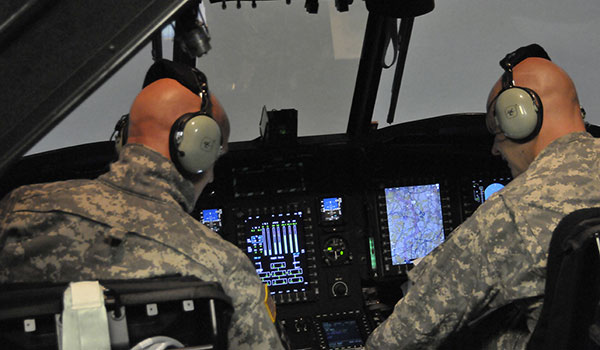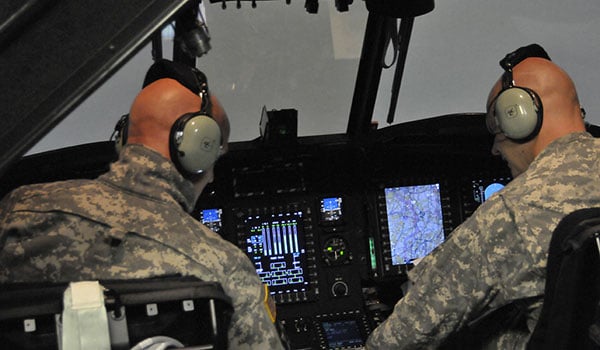
From the Aviation Branch Chief / By MG Michael D. Lundy: As we continue to prepare to fight in unknown and unknowable conditions and threats, leaders who thrive in uncertainty are our primary weapon system. Tough, realistic, performance based training is how we prepare our leaders to operate in these environments.

Simulators, such as this CH-47 Chinook simulator at the Southeast Regional Flight Simulation Training Center on Simmons Army Airfield at Fort Bragg, NC, replicate the complexity of current and future environments and provide the rigor and repetitions necessary to present tough training. / U.S. ARMY PHOTO BY SSG APRIL CAMPBELL
Aviation force structure has been reduced as we continue to implement the Aviation Restructure Initiative, and our combat aviation brigade OPTEMPO continues to rise, so it is critical that we maximize every training opportunity and tool to present our leaders and Soldiers with doctrinally based, tough, realistic training. We need to continue to develop innovative training solutions in the institution and at home station across the integrated training environment.
Army Aviation is the aerial maneuver element in the Army’s core competency of Combined Arms Maneuver. The ability to effectively train air ground operations at home station is critical as we continue to maintain combat readiness during a time of declining resources. A combined effort across the generating and operating force must be synchronized to ensure we can deliver the required training.
The Generating Force
We are aggressively pursuing improvements in Aviation participation in division and corps warfighter exercises (WFX), which are supported by the WARSIM constructive simulation. Recent changes in force structure, creation of AH-64 Attack Reconnaissance Squadrons (ARS) with organic RQ-7 Shadow Unmanned Aircraft System (UAS), new system capabilities, such as manned-unmanned teaming (MUMT) and other modernization efforts necessitate critical updates to WARSIM to ensure accurate behaviors are replicated in mission command exercises. It is imperative that we train our senior commanders and their staffs on current Aviation doctrine and capabilities, which they can see portrayed accurately in a realistic simulation-based exercise.
We are “training our leaders to train” in all of our professional military education (PME) courses. Our lieutenants, captains, warrant officers and NCOs are planning and executing training scenarios in AVCATT, VBS2/3, MUSE and other devices available at home station, and leave the institution with training support packages that can be modified for use at home station.
Another focus area is conducting teamed reconnaissance with our Apache-Shadow reconnaissance/attack weapons systems. The reorganized attack reconnaissance squadrons and troops will have an organic Shadow platoon. In order to ensure that the Scout culture is not lost with the divestiture of the Kiowa Warriors and to teach leaders to plan and conduct operations with Apaches and Shadows employed as a team, the new Air Cavalry Leader’s Course was just established with gaming as the training device that will enable multiple iterations of rigorous training in a short period of time. Again, the Soldiers will leave the course with a TSP to continue that training at home station. The first “pilot course” is being conducted this month (July 2015) with two more planned this fiscal year. This will be a routinely scheduled Additional Skill Identifier (ASI) producing course starting in FY16.
Another important initiative that will improve training at the tactical level will be linking our high fidelity simulators for Apache and Shadow operators. Efforts are already underway to make the Longbow Crew Trainer (LCT) interoperable with the Universal Mission Simulator (UMS). This will enable an Apache crew and a UAS crew to train simultaneously, while they are all in a realistic simulated environment.
Simultaneously, there is also an effort to make the UMS interoperable with the Aviation Combined Arms Tactical Trainer (AVCATT), the collective training system for Army Aviators. This will enable the Shadow operators to interoperate with a team of Apaches. After these efforts are successful, the goal will be for the UMS to interoperate with AVCATT in the Integrated Training Environment (ITE), along with other virtual, live, and collective simulations. To maximize the use and effectiveness of these simulators we must ensure they are concurrent with our modern fleet.
The Operational Force
While there are multiple initiatives underway in the school house, it is important to understand that our Officers and Soldiers spend about 80% of their career in the operational force, and that is where the majority of their training and development will occur. Therefore it is imperative that we leverage all of the tools at our disposal to provide that training. Frankly, our utilization rates for AVCATT and other simulation and gaming devices are way too low.
Our simulation and gaming devices allow commanders to replicate the complexity of our current and future environments, and provide the rigor and repetitions necessary to present tough training for our Soldiers. We should have a 100% utilization rate on our simulation devices. This will enable us to maximize every live flight hour we fly because we will be able to focus on the most important aspects of the training. I need your help in emphasizing the importance of training in simulation.
Additionally, we need to continue the focus on making our training areas and ranges the best they can be. USAACE, in conjunction with the Maneuver Center, just established the requirement that Aviation be included as a part of the Home Station Instrument Training System (HITS). HITS provides an integrated, interoperable, networked training system that will allow Aviation units to support a ground task force across the full range of military operations and provide combat training center (CTC)-like after action review (AAR) capabilities at home station.
As always, I am impressed with the incredible performance of our Aviation Soldiers across the globe. Our Active, National Guard and Reserve units continue to represent the very best our Nation has to offer. Now is the time to seize the opportunity to enhance the training our Soldiers deserve. Thanks for your continued excellent service to our Branch and our Nation.
Above the Best!
MG Michael D. Lundy is the Army Aviation branch chief and commander of the U.S. Army Aviation Center of Excellence and Fort Rucker, AL.










